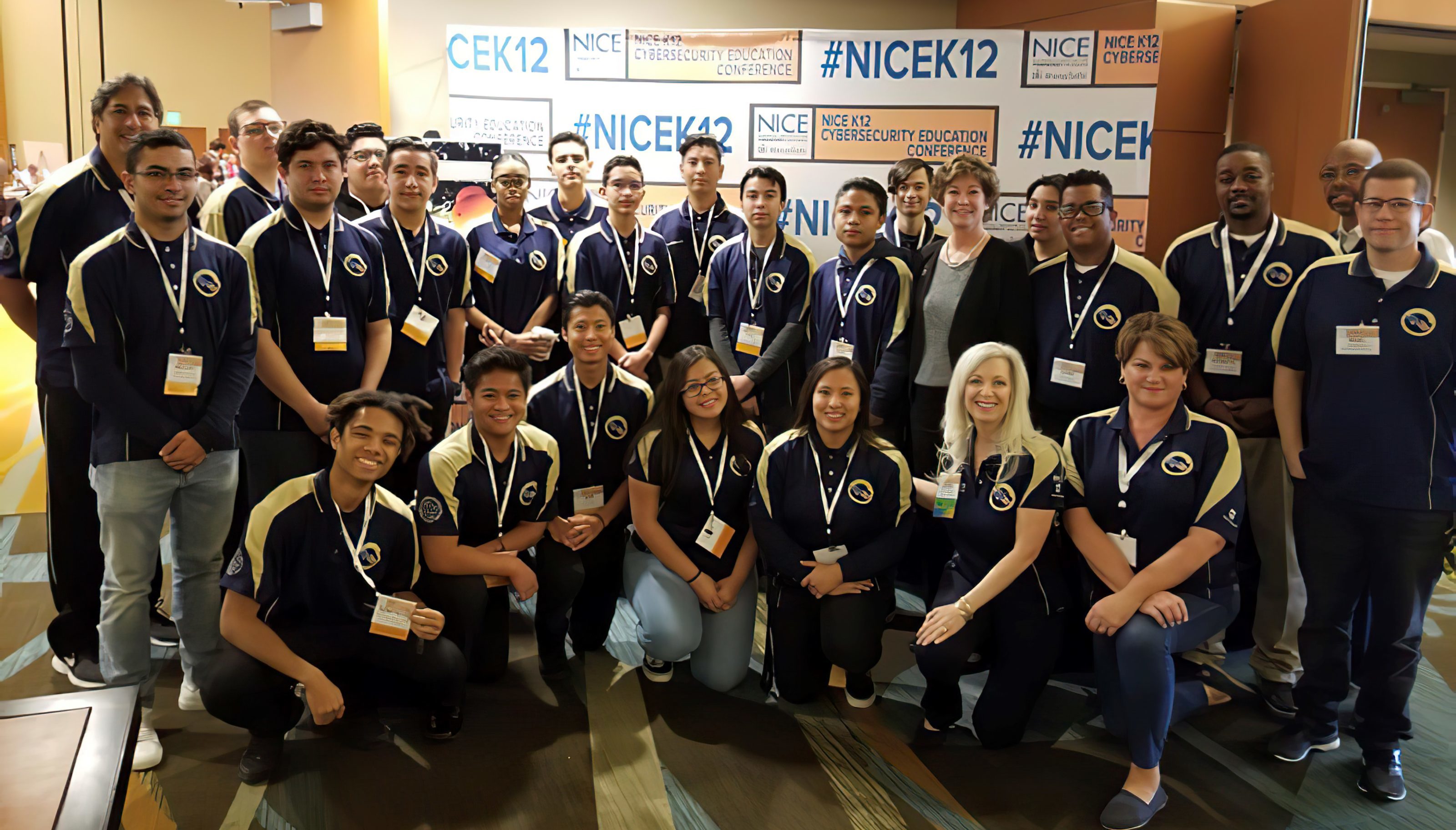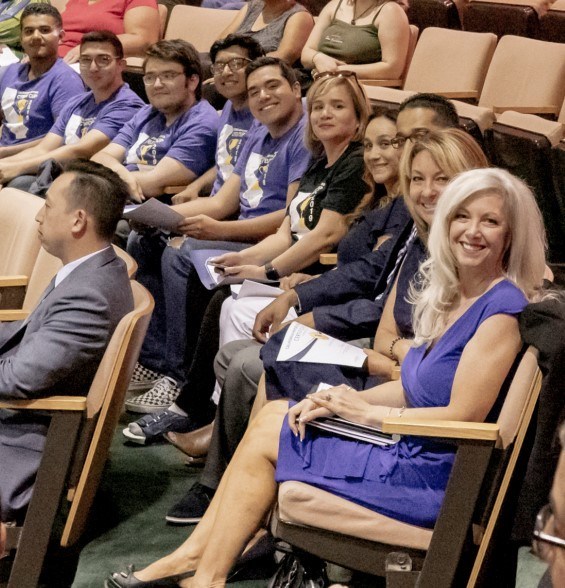

Donna Woods and students at a National Initiative for Cybersecurity Education K-12 conference. Photo: SynED
Foreign countries influencing our elections. Ransomware attacks on hospitals. School districts hacked and confidential records leaked. Identity theft ruining credit and reputations.
These are just some of the problems caused by increasingly sophisticated cyber criminals. Research shows that a cyberattack occurs every 39 seconds in the U.S.

Donna Woods
To combat this trend, teacher Donna Woods co-authored a cybersecurity education pathway program in the Moreno Valley Unified School District six years ago. In May, she was honored with the Presidential Cybersecurity Education Award for her work in that program.
Woods works in the career technical education (CTE) department of her district and has been a teacher at Canyon Springs High School for 20 years. In addition to co-creating the Cyber Academic Pathway program, she authored “a-g” curriculum for the Cybersecurity Levels 1 and 2 courses she teaches. Together with a team of cybersecurity instructors and industry mentors, Woods also leads award-winning CyberPatriot teams, which compete nationally in challenges against other schools to secure virtual networks.

Donna Woods (right), Susanne Mata – Regional Director, ICT-DM Sector for the Inland Empire / Desert Region, Avi Nair, Nikki Cook – Moreno Valley College and the California Mayors Cyber Cup 2019 Inland Empire/Desert Champion team from Grand Terrace. Attending the city council meeting to present the mayor with the perpetual trophy. Photo: SynED
“Cybersecurity is my passion,” says Woods, a member of the Riverside County Office Teachers Association. “The field is so exciting. It impacts every aspect of technology, from our phones and smart technology home devices to our national grid. There is so much to learn.”
The Department of Homeland Security defines cybersecurity as “the art of protecting networks, devices, and data from unauthorized access or criminal use and the practice of ensuring confidentiality, integrity, and availability of information.”
Cybersecurity pays well and is one of the fastest-growing fields in the world, with more than 500,000 unfilled jobs in the U.S. Students are discovering it is a viable and fulfilling career path.
“I thought computers were mostly for playing games,” says Fabio Cornejo, a Canyon Springs graduate now at CSU San Bernardino. “But I joined the CyberPatriot Club in my sophomore year, and things changed. My plan is to be in charge of cybersecurity for a private company. I can’t picture myself doing anything else.”
Amiyah Breeding is a cadet at the U.S. Air Force Academy in Colorado Springs. She credits Woods with helping her land there.
“The Air Force’s mission is to fly, fight and win in both airspace and cyberspace,” says Breeding. “So a basic knowledge of cybersecurity is very important to that mission.”
Over the past five years, the Cyber Academic Pathway has expanded from two high schools to five middle schools in the district, serving grades 6-12. The pathway is a recognized CompTIA Partnership Academy (tech association CompTIA offers certification programs, networking and skills development) and is aligned with framework standards of the National Initiative for Cybersecurity Education (NICE), a partnership of government, academia and the private sector. Palo Alto Networks, Cyber.org, synED, and ConvergeOne are strategic industry partners that develop and support the pre-apprenticeship and work-based learning programs.
Pathway courses are aligned with the Riverside Community College District via articulation and dual enrollment, so students can transfer into higher-level courses and get college credit for high school classes.
During the pandemic, pathway instructors, along with synED, hosted online cyber camps for 400 students from nine states and three countries, and provided summer workshops to 127 teachers. The program also hosted online Girl Scout Cyber Camps on weekends to encourage more females to enter STEAM and computer careers.
“Cybersecurity impacts every aspect of technology, from our phones and smart technology home devices to our national grid.”
Woods became interested in computers in the 1980s, when few women were in the field, through her work in the aerospace industry. When she went to aerospace or computer science conferences, she was mistaken for a secretary.
“I thought about dyeing my blonde hair dark, because people didn’t take me seriously and asked me to get them a cup of coffee,” she laughs.
She began teaching computer skills at the Riverside County Adult Education Program and enjoyed it so much, she decided to earn a teaching credential in information and communications technologies and a master’s degree in workforce education development. She taught computer certification courses at the high school level and then turned her focus to cybersecurity, in partnership with synED, a nonprofit that nominated her for the award (Woods is synED’s academic relations manager).
Woods serves on the governor’s Cybersecurity Task Force, the NICE Working Group and the NICE K-12 planning group.
The presidential award caught her by surprise. She almost didn’t answer the call from a restricted number in Washington, D.C. But when she did, it was U.S. Education Secretary Betsy DeVos informing her of the award, established by executive order in conjunction with the National Security Council’s homeland security adviser and the National Science Foundation.
“Forty-three states submitted nominations, and I had assumed the award was put on hold due to COVID,” says Woods. “I was deeply honored that the collaborative work of our team of instructors and partners was being recognized. When it fully hit me, I began to cry happy tears, as our work has been a very fulfilling journey. We are changing the lives of our students.’’